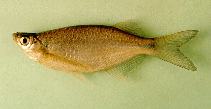| Family: |
Danionidae (Danios), subfamily: Danioninae |
| Max. size: |
10.54 cm TL (male/unsexed); max.weight: 10.4 g |
| Environment: |
pelagic; freshwater; brackish; pH range: 6.5 - 7; dH range: 5 - 10; depth range 0 - 2 m |
| Distribution: |
Asia: Pakistan, India, Bangladesh, Sri Lanka, Myanmar, Malay Peninsula and Indonesia (Ref. 4832). Reported from Nepal (Ref. 9496) and Indochina (Ref. 7050); Mekong and Chao Phraya basins (Ref. 43281). |
| Diagnosis: |
Dorsal soft rays (total): 10-11; Anal soft rays: 20-22. Body depth 2.8-3.6 times in SL; 17-21 branched anal rays (Ref. 12693); conspicuous black stripe on posterior half of body (Ref. 43281). |
| Biology: |
Inhabits the middle-depth area of streams, ponds and tanks. Occurs in shallow and relatively deep areas of streams, both in still and relatively fast-flowing waters. Form shoals with 15-30 individuals. Spawns at dusk or dawn in shallow water with about 30 eggs scattered at a time; egg hatch within 24 hours. Feeds mainly on insects, but also takes plants (Ref. 6028). Rarely seen in markets, probably used to make prahoc. Occasionally imported in the aquarium trade (Ref. 12693). Popular for ornamental purposes (Ref. 44325). |
| IUCN Red List Status: |
Least Concern (LC); Date assessed: 23 January 2010 Ref. (130435)
|
| Threat to humans: |
harmless |
Source and more info: www.fishbase.org. For personal, classroom, and other internal use only. Not for publication.

